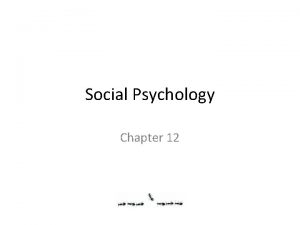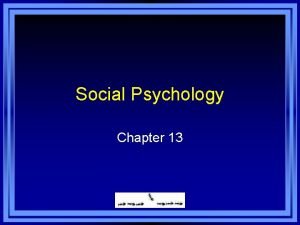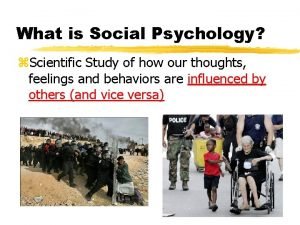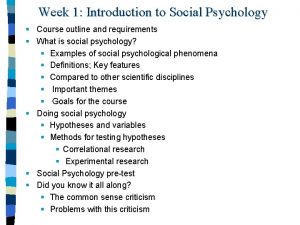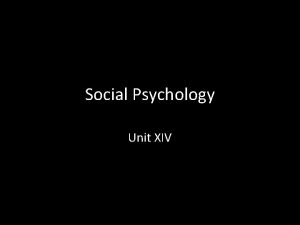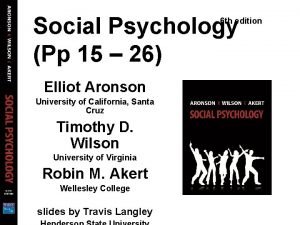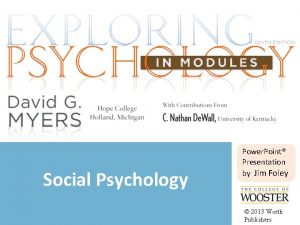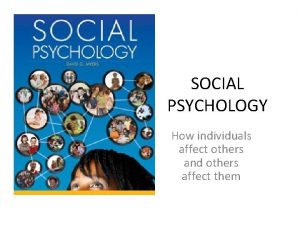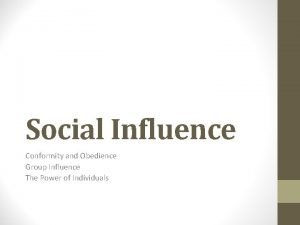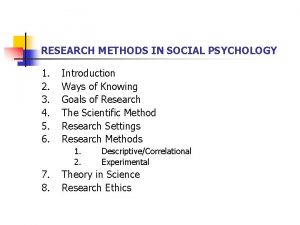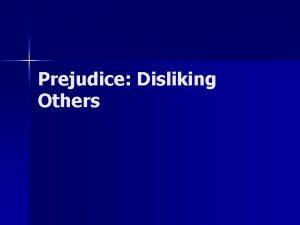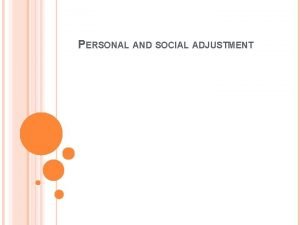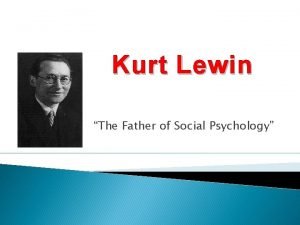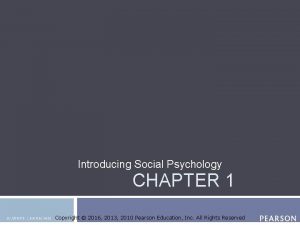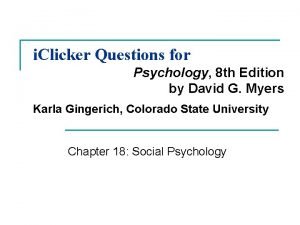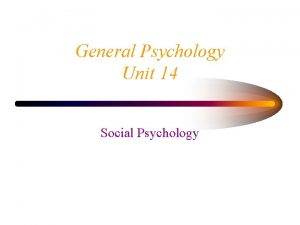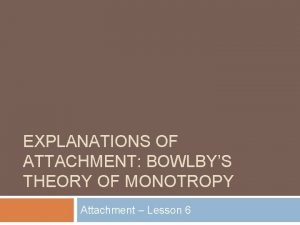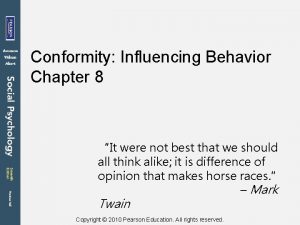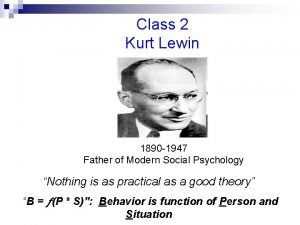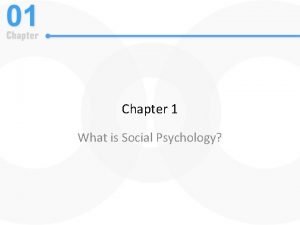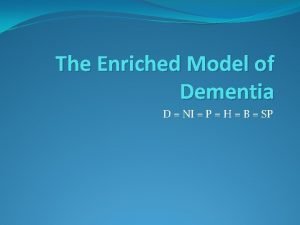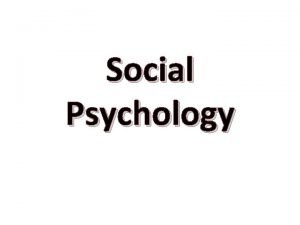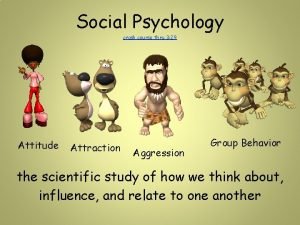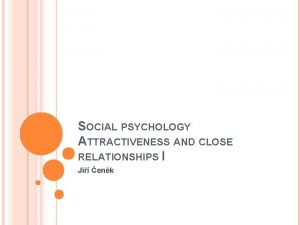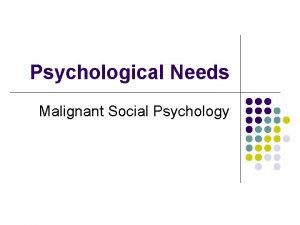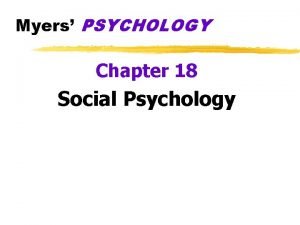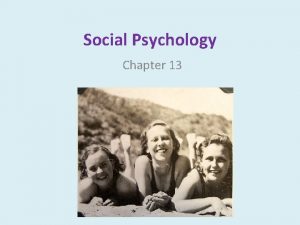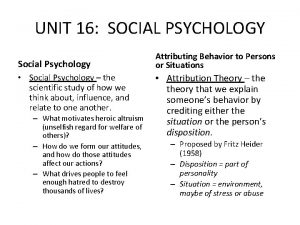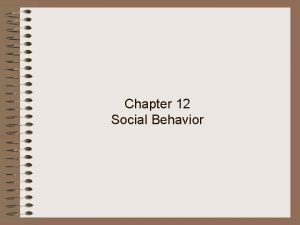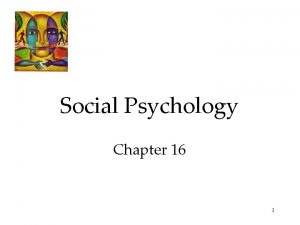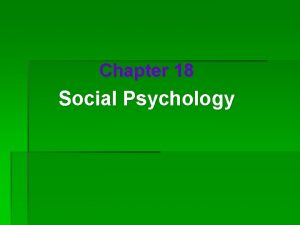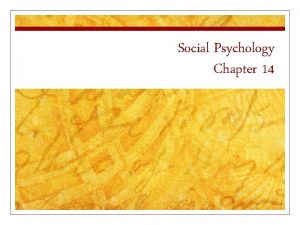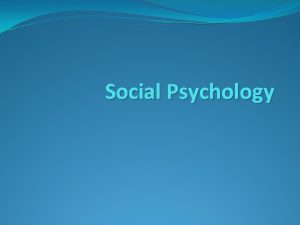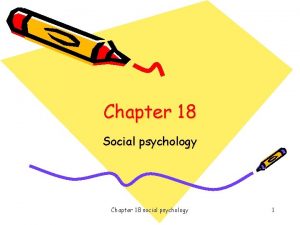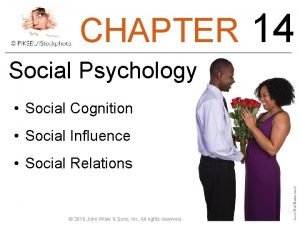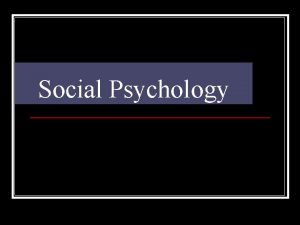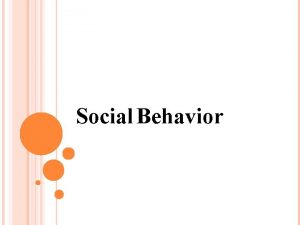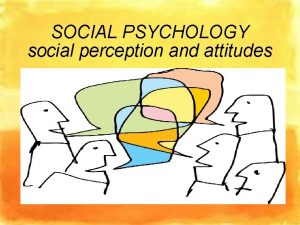SOCIAL PSYCHOLOGY CHAPTER 16 SOCIAL PSYCHOLOGY Social psychology















































- Slides: 47

SOCIAL PSYCHOLOGY CHAPTER 16

SOCIAL PSYCHOLOGY • Social psychology – Is the scientific study of how we think about, influence, and relate to one another • Social psychologists – Use scientific methods to study how people think about, influence, and relate to one another – Study the social influences that explain why the same person will act differently in different situations

SOCIAL PSYCHOLOGY • Social Thinking • When explaining others’ behavior, especially from an individualist Western cultural perspective – Fundamental attribution error committed by underestimating the influence of the situation and overestimating the effects of stable, enduring traits – Behavior more readily attributed to the influence of the situation – Explaining and attributing actions can have important real-life social and economic effects

SOCIAL PSYCHOLOGY • Fundamental attribution error – Is tendency, when analyzing others’ behavior, to overestimate the influence of personal traits and underestimate the effects of the situation – Is most likely to occur when stranger acts badly – Has real-life and social consequences • Napolitan and colleagues (1979) – Students attributed behavior of others to personal traits, even when they were told that behavior was part of an experimental situation.

SOCIAL PSYCHOLOGY • Question of attribution • Whether we attribute poverty and homelessness to social circumstances or to personal dispositions affects and reflects our political views.

SOCIAL PSYCHOLOGY Attitudes Affect Actions • Attitudes are feelings influenced by beliefs, that predispose reactions to objects, people, and events. – Peripheral route persuasion uses incidental cues to try to produce fast but relatively thoughtless changes in attitudes. – Central route persuasion offers evidence and arguments to trigger thoughtful responses

SOCIAL PSYCHOLOGY • Actions can modify attitudes. – Role playing includes acting a social part by following guidelines for expected behavior • Zimbardo’s Stanford Prison Experiment

SOCIAL PSYCHOLOGY • Foot-in-the-door phenomenon – People agreeing to a small request will find it easier to agree later to a larger one – Principle works for negative and positive behavior • Attitudes follow behavior – Cooperative actions, such as those performed by people on sports teams, feed mutual liking. Such attitudes, in turn, promote positive behavior.

SOCIAL PSYCHOLOGY • When attitudes do not fit with actions, tensions are often reduced by changing attitudes to match actions (cognitive dissonance theory). – We act to reduce the discomfort (dissonance) we feel when two of our thoughts (cognitions) clash. – Brain regions become active when people experience cognitive dissonance. – Through cognitive dissonance we often bring attitudes into line with our actions (Festinger).

SOCIAL PSYCHOLOGY • Conformity and obedience – Chartrand colleagues (1999) • Demonstrated chameleon effect with college students • Automatic mimicry helps people to empathize and feel what others feel. • The more we mimic, the greater our empathy, and the more people tend to like us. • This is a form of conformity.

SOCIAL PSYCHOLOGY • Conformity and Obedience • Solomon Asch and others have found that people are most likely to adjust their behavior or thinking to coincide with a group standard when • They feel incompetent or insecure • Their group has at least three people • Everyone else agrees • They admire the group’s status and attractiveness • They have not already committed to another response • They know they are being observed • Their culture encourages respect for

ASCH’S CONFORMITY EXPERIMENTS Which of the three comparison lines on the left is equal to the standard line? The photo on the right (from one of the experiments) was taken after five people, who were actually working for Asch, had answered, “Line 3. ” The student in the center shows the severe discomfort that comes from disagreeing with the responses of other group members.

SOCIAL PSYCHOLOGY • People May Conform For Many Reasons • Normative social influence: To gain approval • Informational social influence: To accept others’ opinions as new information

SOCIAL PSYCHOLOGY SOCIAL NETWORKING INFLUENCE • On the 2010 U. S. congressional election day, Facebook gave people an informational message that encouraged voting. The message had measurably more influence when supplemented with a social message that showed friends who had voted (Bond et al. , 2012).

SOCIAL PSYCHOLOGY • Suggestibility and mimicry sometimes lead to tragedy. – Copycat violence threats after Colorado’s Columbine High School shootings

SOCIAL PSYCHOLOGY Stanley Milgram’s Obedience experiments – People obeyed orders even when they thought they were harming another person. – Strong social influences can make ordinary people conform to falsehoods or exhibit cruel behavior. – In any society, great evil acts often grow out of people’s compliance with lesser evils. In a repeat of the earlier experiment, 65 percent of the adult male “teachers” fully obeyed the experimenter’s commands to continue. They did so despite the “learner’s” earlier mention of a heart condition and despite hearing cries of protest after they administered what they thought were 150 volts and agonized protests after 330 volts. (Data from Milgram, 1974. )

SOCIAL PSYCHOLOGY • In social facilitation (Triplett), presence of others arouses people, improving performance on easy or well-learned tasks but decreasing it on difficult ones. – Performance can also be hindered because the most likely, but not necessarily the correct response occurs. • Home town advantage • Crowding effect • Home team advantage – When others observe us, we perform well-learned tasks more quickly and accurately. – But on new and difficult tasks, performance is less quick and accurate.

SOCIAL PSYCHOLOGY • Social loafing – Tendency for people in a group to exert less effort when pooling their efforts toward attaining a common goal than when individually accountable • Causes – Acting as part of group and feeling less accountable – Feeling individual contribution does not matter – Taking advantage when there is lack of identification with group There is always that one person in the group project that doesn’t do work

SOCIAL PSYCHOLOGY • Deindividuation – Involves loss of selfawareness and self-restraint occurring in group situations that foster arousal and anonymity – Thrives in many different settings Violent Anti-Trump Rioters

SOCIAL PSYCHOLOGY Group polarization • Group discussions with likeminded others strengthen members’ prevailing beliefs and attitudes. • Internet communication magnifies this effect, for better and for worse If a group is like-minded, discussion strengthens its prevailing opinions. Talking over racial issues increased prejudice in a high-prejudice group of high school students and decreased it in a low-prejudice group (Myers & Bishop, 1970).

SOCIAL PSYCHOLOGY • Groupthink • People are driven by a desire for harmony within a decisionmaking group, overriding realistic appraisal of alternatives.

SOCIAL PSYCHOLOGY • Individual power • Power of the individual and the power of the situation interact. • A small minority that consistently expresses its views may sway the majority. Malala

SOCIAL PSYCHOLOGY Social Psychology • Prejudice – Means “prejudgment” – Is an unjustified negative attitude toward some group and its members – Often targets different cultural, ethnic, or gender group

SOCIAL PSYCHOLOGY • Prejudice Components –Beliefs –Emotions –Predispositions to action (to discriminate)

SOCIAL PSYCHOLOGY • Prejudice is a negative attitude • Discrimination is a negative behavior. • Explicit prejudice in North America has decreased over time. – Support for all forms of racial contact, including interracial dating

SOCIAL PSYCHOLOGY • Social roots of prejudice – Social inequalities: Have often developed attitudes that justify status quo – Just-world phenomenon: Good is rewarded and evil is punished. – Stereotypes: Rationalize inequalities.

SOCIAL PSYCHOLOGY • Groups – Through social identities people associate themselves with others. – Evolution prepares people to identify with a group • Ingroup/Outgroup: Social definition of who we are—and are not • Ingroup bias: Favoring of our own group

SOCIAL PSYCHOLOGY • Scapegoat theory – Proposes that when things go wrong, finding someone to blame can provide an outlet for anger • Research evidence (Zimbardo) – Prejudice levels tend to be high among economically frustrated people – In experiments, a temporary frustration increases prejudice

SOCIAL PSYCHOLOGY • Implicit prejudice – Implicit racial associations • Implicit Association Tests results: Even people who deny racial prejudice may carry negative associations – Unconscious patronization • Lower expectations, inflated praise and insufficient criticism for minority student achievement – Race-influenced perceptions • Automatic racial bias – Reflexive bodily responses • Unconscious, selective responses when looking at faces

SOCIAL PSYCHOLOGY • Forming categories – Humans categorize people by race: mixed-race people identified by minority identity – Similarities overestimated during categorization; creating “Us and They” – Overestimation also occurs; other-race effect or bias

SOCIAL PSYCHOLOGY The Biology of Aggression • Biology influences aggression at three levels. – Genetic influences • Evidence from animal studies and twin studies; genetic Y chromosome genetic marker; MAOA gene • Alcohol associated with aggressive responses to frustration – Neural influences • Neural systems facilitate or inhibit aggression when provoked • Aggression more likely to occur with frontal lobe damage – Biochemical influences • Testosterone linked with irritability, assertiveness, impulsiveness, and low tolerance for frustration; alcohol effect

SOCIAL PSYCHOLOGY Psychological and Social-Cultural Factors in Aggression • Adversive events – Frustration-aggression principle: Frustration creates anger, which can spark aggression • Other anger triggers – Hot temperatures, physical pain, personal insults, foul odors, cigarette smoke, crowding, and a host of others – Previous reinforcement for aggressive behavior, observing an aggressive role model, and poor self-control

SOCIAL PSYCHOLOGY Psychological and Social-Cultural Factors in Aggression • Media portrayals of violence provide social scripts that children learn to follow. • Viewing sexual violence contributes to greater aggression toward women. • Playing violent video games increases aggressive thoughts, emotions, and behaviors

SOCIAL PSYCHOLOGY • Psychological and Social-Cultural Influences on Aggression Do violent video games teach social scripts for violence? • Nearly 400 studies of 130, 000 people suggest video games can prime aggressive thoughts, decrease empathy, and increase aggression. • Some researchers dispute this finding and note other factors: Depression, family violence, and peer influence. • As a player of first-person shooter games, Breivik stirred debate when he commented that “I see MW 2 [Modern Warfare 2] more as a part of my training-simulation than anything else. ” Did his violent game playing contribute to his violence, or was it a mere coincidental association? To explore such questions, psychologists experiment.

SOCIAL PSYCHOLOGY Prosocial Relations • Psychology of attraction • Proximity (mere exposure effect) • Physical attractiveness • Similarity of attitudes and interests WHAT DO WE MEAN BY “ATTRACTIVE”?

SOCIAL PSYCHOLOGY • Modern matchmaking • Internet-formed friendships and romantic relationships are on average slightly more likely to last and be satisfying. • Nearly a quarter of heterosexual and two-thirds of same-sex couples met online.

SOCIAL PSYCHOLOGY • Speed-dating • Men are more transparent. • Choices may be more superficial. • Women are more choosy than men.

SOCIAL PSYCHOLOGY • Passionate love – Two-factor theory of emotion • Emotions have two ingredients— physical arousal and cognitive appraisal. • Arousal from any source can enhance an emotion, depending on how we interpret and label the arousal. – Sexual desire + a growing attachment = the passion of romantic love – Passionate love seldom endures • Companionate love – Passion-fed hormones (testosterone) give way to oxytocin that supports feelings of trust, calmness, and bonding – Attraction and sexual desire endure, without obsession of early-stage marriage – Equity is important key to satisfying and enduring relationship – Self-disclosure deepens intimacy

SOCIAL PSYCHOLOGY • Altruism is an unselfish concern for the welfare of others. – People are most likely to help when they notice an incident, interpret it as an emergency, and assume responsibility for helping (Darley and colleagues). – Odds for being helped are also increased if the person appears to deserve help or is a women. – Similarity to self, unhurried or in a good mood, feeling guilty, focused on others and not preoccupied also raises likelihood of being helped.

SOCIAL PSYCHOLOGY • Bystander affect – Tendency for any given bystander to be less likely to give aid if other bystanders are present – Occurs when there is a diffusion of responsibility

SOCIAL PSYCHOLOGY Positive social norms encourage generosity and enable group living. • Socialization norm – Social expectation that prescribes how we should behave • Reciprocity norm – Expectation that people will respond favorably to each other by returning benefits for benefit (cost-benefit analysis; utilitarianism; social exchange theory) • Social-responsibility norm – Expectation that people should help those who depend on them

SOCIAL PSYCHOLOGY

SOCIAL PSYCHOLOGY • Conflict – Perceived incompatibility of actions, goals, or ideas in which people become enmeshed in potentially destructive processes that often produce unwanted results – Among these processes are social traps and distorted

SOCIAL PSYCHOLOGY • Social trap – Situation in which conflicting parties, by each pursuing their self-interest rather than the good of the group, become caught in mutually destructive behavior • Mirror-image perceptions – Mutual views often held by conflicting people, as when each side sees itself as ethical and peaceful and views the other side as evil and aggressive

SOCIAL PSYCHOLOGY • Enemy perceptions – People in conflict form negative, distorted images of one another (mirror-image perceptions) – “Us” versus “Them” develops – Vicious cycle of hostility emerges at individual or national level – Perceptions can become self-fulfilling prophecies

SOCIAL PSYCHOLOGY Research indicates that in some cases contact and cooperation can be transformational. • Contact – Most effective when contact is free of competition and equal status exists – Across a quarter-million people studied in 38 nations, friendly contact with ethnic minorities, older people, and people with disabilities has usually led to less prejudice. – Contact is not always enough.

SOCIAL PSYCHOLOGY • Promoting Peace • Cooperation • Communication • Conciliation
 Psychology experiment
Psychology experiment Social psychology ap psychology
Social psychology ap psychology Social psychology is the scientific study of:
Social psychology is the scientific study of: Social thinking and social influence
Social thinking and social influence Social thinking social influence social relations
Social thinking social influence social relations Chapter 12 social psychology
Chapter 12 social psychology Chapter 13 social psychology
Chapter 13 social psychology Chapter 16 social psychology
Chapter 16 social psychology Application of psychology
Application of psychology Social thinking social influence social relations
Social thinking social influence social relations Positive psychology ap psychology definition
Positive psychology ap psychology definition Introspection methods of psychology
Introspection methods of psychology Health psychology definition ap psychology
Health psychology definition ap psychology Self fulfilling prophecy example
Self fulfilling prophecy example Features of social psychology
Features of social psychology Informational influence
Informational influence Pluralistic ignorance
Pluralistic ignorance Define social facilitation
Define social facilitation Unit xiv social psychology
Unit xiv social psychology Father of social psychology
Father of social psychology Social psychology presentation
Social psychology presentation Social psychology lecture
Social psychology lecture Sociology vs social psychology
Sociology vs social psychology Informational social influence example
Informational social influence example Research methods in social psychology
Research methods in social psychology Nature and power of prejudice
Nature and power of prejudice Examples of social adjustment
Examples of social adjustment Father of social psychology
Father of social psychology Father of social psychology
Father of social psychology Sociology vs social psychology
Sociology vs social psychology Although frieda is typically very reserved as
Although frieda is typically very reserved as Unit 14 reading guide social psychology
Unit 14 reading guide social psychology Monotropic attachment
Monotropic attachment Normative conformity example
Normative conformity example Father of social psychology
Father of social psychology Social trap definition
Social trap definition Social psychology and common sense
Social psychology and common sense Enriched model of care social psychology
Enriched model of care social psychology Historical development of social psychology
Historical development of social psychology Social psychology powerpoint
Social psychology powerpoint Crash course psychology 29 answers
Crash course psychology 29 answers Areas of social psychology
Areas of social psychology Attraction and close relationships in social psychology
Attraction and close relationships in social psychology Kitwoods flower
Kitwoods flower Social trap
Social trap Branches of psychology
Branches of psychology Attribution theory ap psych
Attribution theory ap psych Unit 14 social psychology study guide answers
Unit 14 social psychology study guide answers





